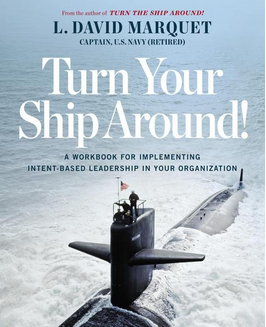Book recommendation Marquet: Turn Your Ship Around!
The workbook "Turn Your Ship Around!", which was published by Penguin in 2015, is based on the book of almost the same name "Turn The Ship Around!" which was published several years earlier and won numerous awards, such as Fortune Magazine and USA Today. It is an excellent impulse for everyone who wants to make their organization agile and fit for a volatile and complex working environment.
What's it about?
The book tells the true story of a captain of the US Navy who, through his leadership approach, managed to turn the then worst US nuclear submarine Santa Fairy into one of the best in the US Navy within two years.
Now one could say that this is the typical fabric of American legends: heroic, competitive, military. Too short thinking. The story captivates precisely because David Marquet manages to initiate a change with his so-called "Intent Based Leadership" approach, which is anything but the supposedly typically military "command and control", but rather sees leadership not in the relationship of leadership and consequences, of "leader and follower", but of "leader leader", which means so much to develop leaders by seeing a leader in every employee himself. Relationships at eye level. Marquet does not abolish the hierarchy, but he creates a different attitude, a new "mind-set".
The story is quite reminiscent of the British polar researcher Shackleton (2003), who saved the majority of his employees from certain death under the most difficult circumstances.

What are the central guiding elements?
The core elements of Marquet's approach are not new or spectacular, but when applied consistently they create an environment that is highly performant:
- People feel valued and proud to be part of a whole that is bigger than they are alone.
- Everyone knows the goals of the organization and knows exactly how they can contribute to achieving them.
- By consistently passing on control and decision-making authority "downwards", employees feel inspired, take responsibility and show authority in their actions even in times of change.
- The success of the organisation rests on the shoulders of everyone and not just on the leaders.
- Leaders exist at all levels and leadership takes place through all of them.
Why is this leadership approach helpful?
Therefore, it is a question of enabling everyone to make appropriate decisions in each situation. An important factor in a volatile, complex and highly dynamic world. This requires information on the one hand, but also clarity about the objectives and the certainty of being able to make decisions on the other. Information must therefore be closely linked with every employee, everyone must have the best possible overview of what is happening in the (sub-) organisation in order to be able to make appropriate situational decisions at all. These decisions must be based on the purpose of the organisation and must not harm it. This requires confidence in leadership, not to be sanctioned even in the event of wrong decisions. This results in speed and a higher decision quality. The opposite of classical hierarchical organizations, in which decisions are made by people who reside on many levels above them - this makes decision-making processes sluggish and often wrong.
What does the book offer for managers?
The workbook consists of 5 parts, which are divided into a total of 29 chapters. In the first part Marquet develops his general ideas about leadership. The following three chapters deal with the three core elements of his leadership approach: control, competence and clarity. And the last part rounds off again, which is helpful for the implementation of the approach. In each chapter, which builds on each other in a well-structured way, there is a short explanation explaining the concept. This is followed by questions that everyone can answer for themselves in order to reflect on their personal thinking and behaviour. Each chapter concludes with numerous activities for implementation.
Again, and again there are references to the work "Turn the ship around!" on which the workbook is based. Since the thoughts are not completely new, however, the numerous information on David Marquet's website is also sufficient for understanding.
The approach provides a good basis for all organizations that want to become more agile in the future and have recognized that a different kind of leadership and leadership culture is necessary. Of course it is not enough to read a book, but it requires a general examination of the existing culture and the desired image of the future. Such a transformation does not happen overnight, but requires a development process that requires a certain stamina. In Marquet's example, it took 2 years, but the first successes were noticeable much earlier. The book is described as concretely as possible and offers numerous approaches and ideas that are worth reflecting on and implementing. But no book can be touched upon as a recipe for an organization, but always needs the respective, individual fit, so that something unique and unique can emerge for the respective organization and its culture. This makes them robust for the competition and the future. For such a transformation process, however, the book or the approach developed in it can be used as a wonderful basis.
If you are interested in this topic or have questions, then please inform yourself further about our services in this area or simply contact us.
Literature:
- Morell, M. & Capparell, S. (2003). Shackleton's art of leadership: What managers can learn from the great polar explorer. Reinbek: Rowohlt.

